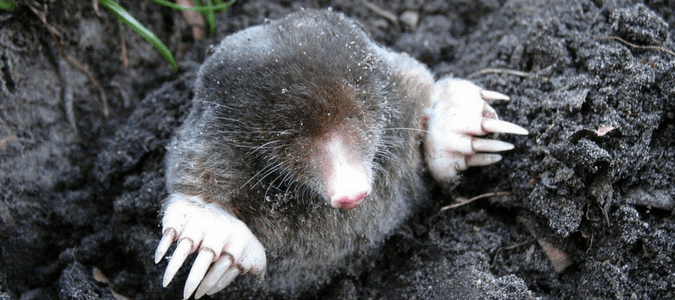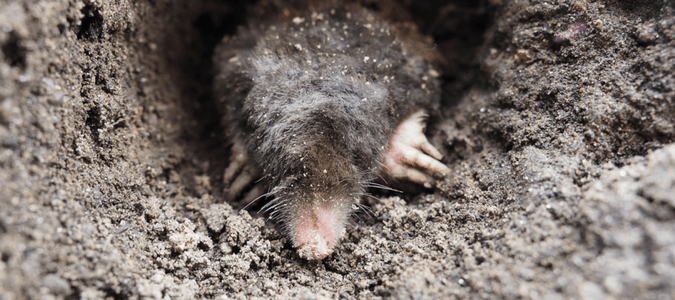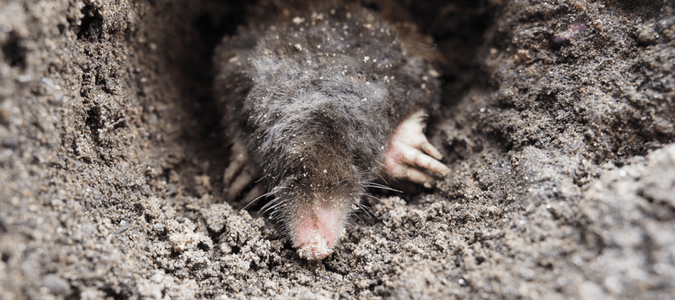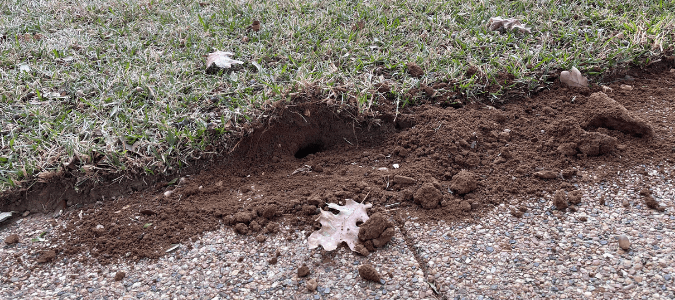The Eastern Mole is the most common species of mole in North America. They live their entire lives in complex networks of interconnecting underground tunnels. If you have noticed these unsightly tunnels in your own yard, you may be wondering what you can do to get rid of moles in your yard.
The first step to figuring out these pests’ activities is learning what moles eat. Moles eat insects, worms, grubs and other invertebrates which they access by these tunnels which connect to shallower tunnels below the surface.
The small, potato-shaped creatures are voracious eaters. While they don’t eat plants or plant roots, they can burrow through and destroy wide swaths of lawns and gardens in a single night while on the hunt for their next meal. Moles can burrow up to 18 feet in a single hour and are most active at dusk and dawn.
Moles are most attracted to soft soil areas that are home to insects, earthworms, grubs and other invertebrates, making both flower and produce gardens attractive.
How to Get Rid of Moles in Your Yard
The best way to get rid of moles is to physically remove them from your property. Then, do everything you can to make it inhospitable to new arrivals. Eliminating food sources is key. Using traps and repellents have varying degrees of success. The most efficient means of regaining your land from invasive moles is to contact a trained professional for mole control.
Eliminating Food Sources
Moles feed on soil-dwelling invertebrates and insects, especially grubs. Using nematodes, a parasitic worm and milky spores to remove these grubs can be helpful in removing the mole’s key food source. This can entice them to move on. That said, moles can find a variety of other food sources on your property, such as earthworms. Earthworms are an essential part of a healthy lawn, so you don’t want to eliminate them from your property.
Repellents
Mole and gopher repellents are made in both liquid and granular form, and are simple to apply using a manual spreader or straight from the bag. Read the product label for any warnings, but most products will be plant and pet-friendly.
A popular home remedy, castor oil, is a non-lethal repellent, upsetting the animal’s digestive tract and discouraging them from revisiting specific areas. Castor oil can be used by soaking tunnels and entrances with a mixture of castor oil, dish soap and water.
Other remedies like mothballs, cayenne pepper or tea tree oil are ineffective as mole repellents and should be avoided.
Sonics and Scents
Sonic stakes emit ultrasonic pulses and vibrations that can irritate and confuse moles, shrews, gophers, voles and other subterranean critters that live beneath the surface of your yard. Sonic stakes are solar-powered, waterproof and take around 8 hours of daylight to charge. Most brands can remain in use for up to 5 days on a single charge.
If you don’t own dogs, cats or other pets that may be a natural deterrent for moles, the use of predator scents, like coyote urine, can drive subterranean pests away for months at a time. Take caution using these scents in areas that are a habitat for the real predators.
The last thing you want to do is trade a few moles for a pack of wild coyotes!
Traps
There are a wide variety of trap styles, in a wide range of prices, available at most hardware stores and from manufacturers online. Keep in mind that most traps effectiveness is based on the size of the animal, so a trap designed for a mole isn’t going to help deal with gophers.
Most mole traps come with simple-to-follow set-up instructions and are baited with fruits, plant roots or vegetables. Most traps are made to be set near or just inside the burrow entrance and should be checked daily.
Pet owners should take special care to keep animals inside and away from traps for as long as they are active.
The most effective time to trap moles is in the early parts of spring or fall when the creatures are the most active in feeding and tunneling.
Preventing Moles from Returning
Because moles live most of their lives underground and out of sight, prevention can be difficult. In other words, you won’t know that you have a mole problem until you have a mole problem.
Still, once you’ve dealt with moles, there are some actions you can take to discourage them from returning.
- Deal with Current Tunnels. Filling in openings and compressing the ground around openings can help keep new invaders from taking advantage of past moles’ homes.
- Watch the Area. Do regular check-ups of previously infested areas, watching for fresh signs of moles. Treat and level any new mounds and remove weeds and garden debris, which can encourage insect larvae, which moles eat. Monitoring is especially important if the affected areas border vacant lots or wild growth areas that are less likely to be treated for moles. Contacting a pest control professional is often the best way to prevent these pests from returning.
- Limit Access. Underground fencing and border walls that extend at least a foot below the surface can help limit their access to specific areas of lawns or gardens. However, this can become expensive and impractical for larger areas.
Moles Versus Gophers
Moles are distinctive critters, with their pointed muzzles, bright pink noses, long claws and paddle-like webbed feet, as you can see in the image above.
Most moles grow between seven and ten inches long and weigh up to 8 ounces. They are covered in black or very dark grey fur. Both ears and eyes are tiny and covered by their fur, making them appear to be blind and deaf.
Quick Facts About Moles:
- A mole’s gestation period is four to six weeks, giving birth to up to seven pups in each litter
- Pups will remain with the mother for a month following birth
- A mole pup will reach maturity in ten months, with an average lifespan of four to six years
- Raised humps of soil or sod that crisscross the yard
- Areas of dead or discolored plants or grass, where moles have detached roots while burrowing
- Raised molehills marking tunnel entrances (typically around 6″ tall and shaped like a volcano or football)
Moles are most active during spring and fall, slowing their activity during extreme hot or cold weather. They usually increase their tunneling efforts during wet weather when the soil is softest. Moles in Texas and other temperate climates will be active all year long.
Gophers
Unlike moles, gophers actually are rodents. Pictured above, these herbivores have four large incisors which continue to grow throughout the animal’s life. Larger than mice, but smaller than rats, gophers lack the shovel-like forepaws of moles.
Gophers have large claws, short limbs, loose skin, whiskers and small eyes and ears. Most gophers have some shade of gray or brown fur while their tails have little to no hair at all. Gopher mounds are easily mistaken for mole mounds. One difference is that they tend to be more crescent-shaped and the entrances are usually plugged.
Tunnels are typically deeper underground than mole burrows and are not visible from the surface.
One thing gophers share with moles is their strong appetite, destroying everything from flowers to small trees while feeding on their roots. They love garden vegetables as well, especially root veggies like carrots and potatoes. They will decimate waterlines and irrigation systems in their constant search for food.
Like moles, the best way to deal with gophers is to create an inhospitable environment and deny them access to their preferred food sources.
Do Moles Carry Diseases?
Although rare, moles can transmit rabies. The fleas and ticks that they’re host to are a more realistic threat, as they can get passed along to both humans and pets with no direct contact. Lyme disease, a serious health condition, can be spread by moles via their fleas, as well.
Seeking Help
The hard truth is that, by the time most folks realize that they have a mole infestation, these pests have built tunnels, exits and places to hide.
At this point, it’s nearly impossible for the homeowner to get rid of them on their own.
The fastest and most cost-effective solution is contacting the help of a pest control professional. An expert pest control service provides peace of mind that the best tools, training and tactics are being used against your lawn invaders. You’ll also have peace of mind knowing you’re taking the best possible steps to ward off their return.
ABC Can Control the Moles on Your Property
Once you realize you have moles in your yard, the best way to deal with them is by contacting a professional pest control team that specializes in mole control. ABC Home & Commercial Services can control your pest problem.
We use a machine called the BurrowRX that blows carbon monoxide smoke into the tunnel and eliminates the moles. However, this is both kid- and pet-friendly as the smoke dissipates into the air. In addition, we use a mole repellent made of citronella, garlic and other natural products. This way, you won’t have to worry about your mole problem anymore and you won’t have to worry about the potential impact on your environment.




